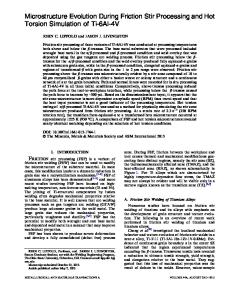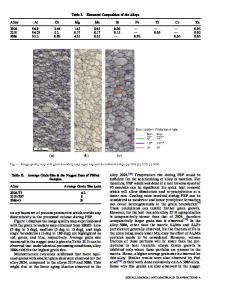Microstructure and Texture Evolution during Friction Stir Processing of Fully Lamellar Ti-6Al-4V
- PDF / 2,552,916 Bytes
- 22 Pages / 593.972 x 792 pts Page_size
- 36 Downloads / 330 Views
TRODUCTION
FRICTION stir processing (FSP) is a solid-state metal working technique based on the principles of friction stir welding (FSW). FSP and FSW involve plunging a rotating, cylindrical tool that has an extended, concentric pin with a smaller diameter into a plate, or a seam between two plates, and traversing the tool across it. Friction between the tool and workpiece generates extreme temperatures, which lower the flow stress of the material and permit significant amounts of plasticity in the vicinity of the rotating tool. This, in turn, imparts substantial strain to the workpiece resulting in refinement of the microstructure. During FSP, no weld is created so the tool plunge depth becomes a process parameter that can be used to adjust the total heat input into workpiece in order to tailor the stir zone microstructure. There has been recent interest in FSP of cast alloys,[1] which have intrinsically lower strength and ductility due to the coarse grains prevalent throughout the as-cast microstructure. In fact, the process has been used to refine the microstructure of cast aluminum,[2,3] magnesium[1] and nickel-aluminum-bronze alloys.[4–6] Recent work by the present authors showed that FSP can also be used to refine the coarse, fully lamellar microstructure of investment-cast and hot isostatic pressed Ti-6Al-4V A.L. PILCHAK, formerly Graduate Research Associate, Department of Materials Science and Engineering, The Ohio State University, is Visiting Scientist, Air Force Research Laboratory, Materials and Manufacturing Directorate/RXLM, Wright Patterson Air Force Base, OH 45433, and Research Scientist, University Technology Corporation, Dayton, OH 45432. Contact e-mail: [email protected] J.C. WILLIAMS, Professor and Honda Chair Emeritus, is with the Department of Materials Science and Engineering, The Ohio State University, Columbus, OH 43210. Manuscript submitted September 27, 2009. Article published online November 19, 2010 METALLURGICAL AND MATERIALS TRANSACTIONS A
(Ti-6-4).[1,7,8] Different microstructures can be created depending on the peak temperature in the stir zone relative to the b transus temperature. During subtransus processing, the stir zone microstructure consisted of approximately 1-lm equiaxed a grains, while it consisted of 25- to 30-lm prior b grains containing a + b colonies during supertransus processing. These were called the a/b and b friction stir processed conditions,[9,10] respectively, which signified the phases that were present in the stir zone at the peak processing temperature. Both stir zone microstructures were considerably refined from the cast condition, which had prior b grains larger than 1 mm in diameter with colony sizes typically exceeding 500 lm. The characteristics of the grain refinement mechanism during subtransus FSP were suggested to be consistent with continuous recrystallization[1] as opposed to classical recrystallization via nucleation and growth or dynamic recrystallization. However, additional analyses performed since the preliminary results were published have
Data Loading...











